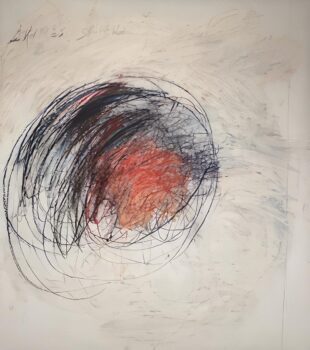What Was Cy Twombly Known For
In the vast and varied universe of 20th-century art, few figures are as enigmatic, poetic, and enduring as Cy Twombly. Known for his seemingly chaotic scribbles, layered calligraphic gestures, and references to classical mythology, Twombly’s work often straddles the line between visual art and literature. To the uninitiated, his paintings might look like a child’s doodle or frantic notes scrawled on a chalkboard. But behind the mark-making lies a rich tapestry of historical depth, intellectual rigor, and emotive power.
This story delves into Cy Twombly’s artistic legacy, exploring how he created his work, what he’s known for, his most iconic pieces, the art styles he’s associated with, the materials he used, the current market value of his work, and where one can find his paintings today.
Who Was Cy Twombly?
Born in Lexington, Virginia in 1928, Edwin Parker “Cy” Twombly Jr. was named after the famed baseball player Cy Young. From an early age, Twombly showed a fascination with art, eventually studying at the School of the Museum of Fine Arts in Boston, Black Mountain College in North Carolina, and later the Art Students League in New York. It was during his time at Black Mountain that Twombly encountered influential mentors like Robert Motherwell and Franz Kline, and befriended fellow students such as Robert Rauschenberg.
Though he was American by birth, Twombly spent much of his adult life in Italy, a country that deeply informed his aesthetic sensibilities. The ruins of ancient Rome, Greco-Roman myths, and Renaissance poetry are deeply embedded in the fabric of his work.
Cy Twombly is best known for his large-scale, graffiti-like paintings filled with scribbles, calligraphic lines, and abstract forms. Unlike many of his contemporaries in the Abstract Expressionist movement, Twombly’s work emphasized not just gesture but also language and narrative. His canvases often include handwritten words, fragments of poems, names of mythological figures, or Latin phrases, scratched, scrawled, or delicately written into the paint.
His style evolved over decades, but his unique fusion of abstraction, text, and history remained consistent. Twombly’s work is intensely personal, often drawing on ancient history, mythology, and literature to create modern mythopoetic landscapes.
How Did Cy Twombly Make His Artwork?
Cy Twombly’s process was visceral, physical, and deeply intuitive. He famously painted with his entire body, often stepping back to view the canvas, then lunging forward to attack it with frenzied scribbles or fluid marks. In the 1950s and ’60s, Twombly began using a technique called “automatism”, a method inspired by the Surrealists in which the artist allows the hand to move freely across the canvas, tapping into the subconscious.
Twombly used unconventional tools, his fingers, rags, mops, and even sticks, to apply paint. He sometimes smeared paint with his hands or dragged it across the surface with improvised brushes. His handwriting, often seen in his paintings, was not simply a decorative element, it was integral to the rhythm and emotion of the piece.
The text in his work was not meant to be read in a literal sense but rather felt. It offered clues, fragments of meaning that added to the emotional and historical weight of the image.
What Materials Did Cy Twombly Use?
Twombly’s choice of materials was as varied and expressive as his marks. His media included:
Oil-based house paint
Crayon and colored pencils
Graphite and chalk
Ballpoint pens
Acrylics and oil paint
Pencil and wax crayon on paper
Collage elements and photography
He was also known to experiment with layering, often building up surfaces over time, allowing earlier markings to show through. In some cases, he would revisit a canvas months or even years after its initial creation.
Twombly worked on both canvas and paper, producing large-scale paintings and more intimate drawings. His mixed-media pieces, combining paint with pencil, ink, and collage, are among his most fascinating.
What Art Style Is Cy Twombly Associated With?
Cy Twombly is most closely associated with:
Abstract Expressionism
Neo-Expressionism
Minimalism
Conceptual Art
However, his style defied strict categorization. While his early work bore similarities to Abstract Expressionists like Jackson Pollock, Twombly rejected the heroic masculinity often associated with that movement. His use of text and classical allusion brought him closer to Conceptual Art, yet his emphasis on emotional gesture aligned him with Neo-Expressionists.
Many critics describe Twombly’s art as poetic abstraction, a unique hybrid that combines visual rhythm with intellectual depth. His work represents a deeply personal language, both visual and textual, rich with cultural memory and emotional resonance.
What Are Cy Twombly’s Most Famous Artworks?
Some of Twombly’s most iconic and celebrated works include:
1. “Leda and the Swan” (1962)
An interpretation of the Greek myth in which Zeus seduces Leda in the form of a swan. The painting is a frenzied explosion of smears, scratches, and poetic violence, capturing the raw sensuality of the story.
2. “Apollo and the Artist” (1975)
A meditation on the mythic connection between Apollo, the god of poetry and art, and the artist himself.
3. “Four Seasons” Series (1993–94)
Also known as Quattro Stagioni, this cycle of four paintings represents the seasons and was created later in Twombly’s life. These monumental pieces blend expressive brushwork with poetic references to nature and time.
4. “Untitled (Bacchus Series)” (2005)
A series of dramatic red looped lines painted on large canvases. These works channel the chaos and ecstasy of Bacchus, the god of wine and revelry.
5. “Untitled (New York City)” (1968)
One of his most famous minimalist works, a white canvas covered with looping gray lines that resemble handwriting or musical notation.
How Many Artworks Did Cy Twombly Create?
While there is no exact count, Cy Twombly created several hundred paintings and thousands of drawings during his lifetime. His output included:
Large-scale paintings
Drawings and sketches
Sculptures (often made from found objects)
Works on paper
Photographic series
He also produced various art journals, filled with sketches, poems, and ideas, many of which remain unpublished or held in private collections.
How Much Does Cy Twombly’s Art Cost?
Cy Twombly’s work commands multi-million-dollar prices on the art market. He is considered one of the most valuable postwar artists in the world.
In 2015, his painting “Untitled (New York City)” (1968) sold at Sotheby’s for $70.5 million.
Another painting, part of the Bacchus series, sold for over $46 million.
Works on paper or smaller canvases can range from $500,000 to $10 million, depending on provenance, subject matter, and period.
Twombly’s market has remained extremely strong due to limited supply, high demand among collectors, and institutional recognition.
Where Can You See Cy Twombly’s Artwork Today?
Cy Twombly’s art is featured in major museums and institutions around the world. Some key locations include:
1. The Cy Twombly Gallery, Menil Collection, Houston, Texas
This dedicated space showcases a permanent selection of his work in collaboration with the artist himself before his death. It’s considered one of the most comprehensive Twombly collections.
2. Museum of Modern Art (MoMA), New York
MoMA holds several important Twombly pieces in its permanent collection.
3. Tate Modern, London
Tate owns some significant works and has hosted major retrospectives of his career.
4. Centre Pompidou, Paris
This French institution features Twombly’s work within its modern and contemporary collections.
5. Gagosian Galleries Worldwide
Gagosian is the primary gallery representing Twombly’s estate, exhibiting his work globally in cities like New York, Los Angeles, Paris, and Hong Kong.
6. National Gallery of Art, Washington, D.C.
A major collection of his drawings and paintings is housed here, representing his deep connection to American art history.
A Legacy of Elegy and Ecstasy
Cy Twombly passed away in 2011, but his legacy continues to resonate across generations of artists, writers, and thinkers. In a world that often prizes clarity, his work celebrates ambiguity, emotion, and the fragmented beauty of memory. His canvases are like palimpsests, layers of time, thought, and feeling, etched onto the surface of modern art.
He once said, “Each line is now the actual experience with its own innate history. It does not illustrate, it is the sensation of its own realization.” That statement encapsulates the heart of his art: raw, unfiltered experience made visible.
For those who take the time to look beyond the scribbles, Cy Twombly’s work offers a universe of meaning, where poetry meets paint, and history merges with heart.
Whether you’re a seasoned art lover or a curious newcomer, the next time you encounter a Cy Twombly, pause and look deeper. Beneath the surface chaos is a symphony of passion, intellect, and myth that continues to inspire, provoke, and move us.




